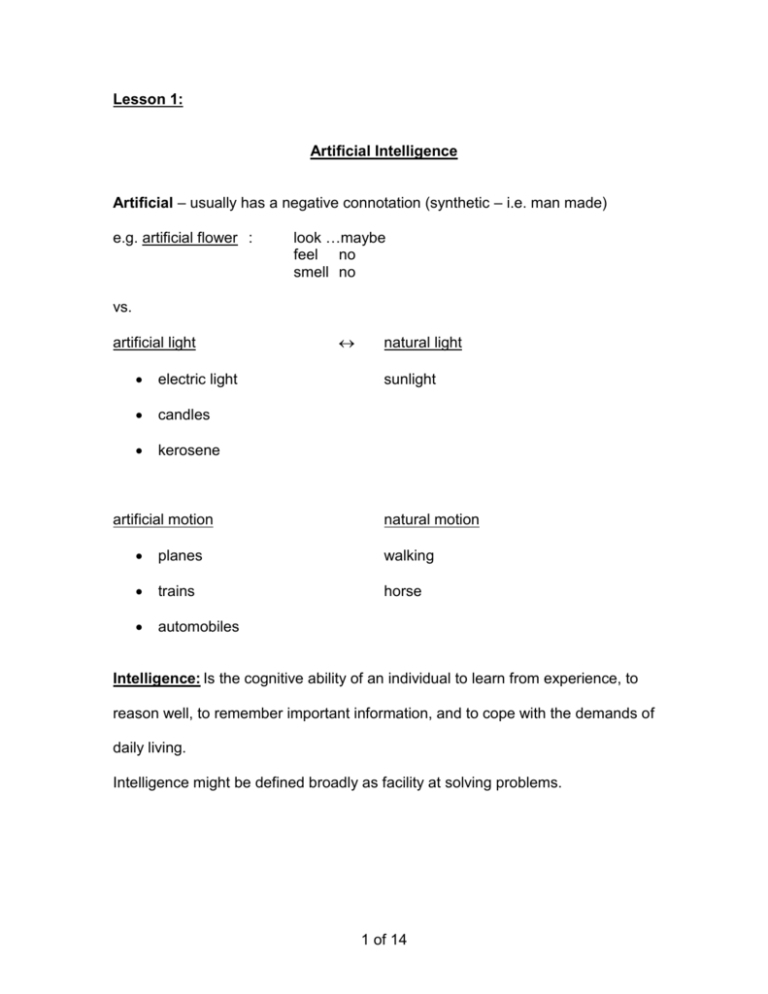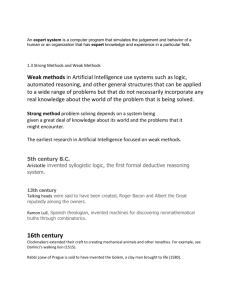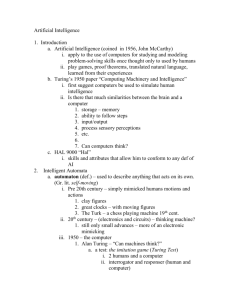Artificial Intelligence
advertisement

Lesson 1: Artificial Intelligence Artificial – usually has a negative connotation (synthetic – i.e. man made) e.g. artificial flower : look …maybe feel no smell no vs. artificial light electric light candles kerosene artificial motion natural light sunlight natural motion planes walking trains horse automobiles Intelligence: Is the cognitive ability of an individual to learn from experience, to reason well, to remember important information, and to cope with the demands of daily living. Intelligence might be defined broadly as facility at solving problems. 1 of 14 Sequences: 1, 3, 6, 10, 15, 21, ? 28 is next Triangular numbers n nth entry = i 2 e.g. 2nd triangular # = i 1 2 3 i 1 i 1 1, 2, 2, 3, 3, 3, 4, 4, 4, 4, ? 2, 3, 3, 5, 5, 5, 7, 7, 7, 7, ? 0, 1, 2, ? 3 … not so fast! Another possibility … 0 = 0 1! = 1 2!! = (2!)! = (2x1)! = 2! = 2 3!!! = (3!)!! = ((3x2)!)! = (6!)! = 720! 23, ? And finally … 9, 14, 2 of 14 Artificial Intelligence is the science of making machines do things that would require intelligence if done by man. Building Intelligent Systems Knowledge Representation o Production rules …if cond then result o Logic o Frames o Scripts o Semantic networks Frames and scripts utilize the prototypical nature of most events, e.g. visits to a restaurant, dentist , etc. Search o Blind search – no knowledge of problem domain A B D C E F G Depth first search (dfs) A,B,D,E,C,F,G Breadth first search (bfs) A, B, C, D, E, F, G vs o Heuristic search – employ estimates of closeness to goal. 3 of 14 Learning – improved performance via practice Paradigms – connectionist – artificial neural networks (ANN) e.g. learning a Boolean function – pattern classification X1 0 0 1 1 X2 0 1 0 1 X1* X2 0 0 0 1 Feature extraction How would you teach this to a child? Reward when correct, “punish” when wrong. SUPERVISED LEARNING This scales up – male or female? What are features here? Evolutionary Computation Charles Darwin – British naturalist “I have called this principle, by which each slight variation, if useful, is preserved, by the term natural selection” – Charles Darwin from “The Origin of Species”, 1859 4 of 14 “Darwin’s theory of evolutionary selection holds that variation within species occurs randomly and that the survival or extinction of each organism is determined by that organism’s ability to adapt to its environment.” www2.lucidate.com/lucidate/library Survival of the fittest Natural selection occurs in nature at a rate of thousands or millions of years. Inside a computer – evolution proceeds somewhat faster. Genetic Algorithm – the problem is encoded as a string Example: 3-puzzle Start State 2 Goal 3 1 1 2 3 Operators … where we assume it is the blank that moves Encode these operators as binary strings… 5 of 14 For example, 00 01 10 11 A solution for this puzzle (when one exists) consists of a series of moves. Such a solution (whether successful or not so) may thus be represented by a binary string. For example, the string: 001101 2 corresponds to: 3 00 º 1 2 11 º 1 3 2 3 1 2 01 º 1 3 // we’re getting close! To each such string we shall attach a fitness function. What metric would you propose? 6 of 14 With a genetic algorithm (GA) we would begin with a population of such strings. Initial Population S1: 1110111011101110 S2: 0011011000110110 . . . Sr: 0011010001000110 Selection Much as in human reproduction, these strings are permitted to “mate” based on their fitness. Crossover Strings “share genetic material” ….. a crossover point is generated randomly Before A: 01110011 Crossover B: 10011000 Same as A From B After Crossover A’: 01110000 B’: 10011011 Same as B From A Mutation – spontanteous variation with a small probability, say .001 A bit in a string may change 0 1 or 1 0 7 of 14 Genetic Algorithms – con’t. Initial Population String 1 String 2 . . . .String r Fitness F0 Selection Crossover Mutation Second Population String 1' String 2' . . . .String r’ Fitness F1 . . . . Nth Population String 1n String 2n . . . .String rn Fitness Fn It is certainly the case that Fn >> F0 and either Fn contains a string that solved the given problem or comes very close. 8 of 14 Learning Paradigms con’t. Genetic Programming: Proposed programs are permitted to share their code Inductive Learning: Generalization from a set of examples Returning to the issue of intelligence…. How does one decide if someone (something?) is intelligent? Are animals intelligent? Dogs? Cats ? Ants ? Dolphins ? And if so, how would one measure it? … Clever Hans – Berlin, circa 1900 9 of 14 Intelligence – con’t. Intelligence is the characteristic almost universally agreed upon as setting humans apart from ( and above? ) other creatures. The declared goal of artificial intelligence research is to teach machines to “think”, i.e. to display those characteristics usually associated with human intelligence. Pivotal question: Can Machines Think? The answer may not be a neat yes or no, but rather a highly qualified “to a certain extent under special conditions.” Does a person, animal, machine possess intelligence … the answer is not binary : Some people are smarter than others Some animals are smarter than others Turing rephrased this question in operational terms. i.e. he sought to separate functionality from implementation. 10 of 14 Measuring Intelligence Alan Turing (1950) proposed two imitation games In the first: Man (lies) An Interrogator Woman (truthful) Curtain A series of questions is asked. The interrogator must determine if it is a man or woman on the other side of the curtain. If a man is successful in deceiving the interrogator, then we say that he has passed this imitation game. What questions would you suggest? The second… The Turing Test for intelligence Computer (lies) An Interrogator Person (truthful) Curtain Questions? Loebner Prize of $10,000 Is it a computer or a human? If the computer is successful in deceiving the interrogator then we say that it has passed the Turing Test. 11 of 14 Turing Test (con’t.) Proposed Questions: 1,000,017 …not a good idea, why not? Are you afraid of dying? How does the dark make you feel? What does it feel like to be in love? Is this a valid barometer for intelligence? Block’s criticism of the Turing Test English text may be encoded in ASCII inside a computer ( in fact it is! ). Hence, a particular Turing Test which is a series of questions and answers may be stored as a (very large) number. In fact, one could envision many instances of the Turing Test being stored on a very large database. Passing the test could then be accomplished by table lookup. Granted, such a computer system does not exist at present… But if it did, would you feel comfortable in calling this computer intelligent? 12 of 14 The Chinese Room Searle’s criticism of the Turing Test The Chinese Room Once again, we have an interrogator who will ask questions – this time - in Chinese. And in a room we have an individual who does not know Chinese; however, that person possesses a very detailed “rule book.” To most people who do not know Chinese, the language appears as squiggles. Questions in Chinese Interrogator Person Answers in Chinese Rule book Does this person know Chinese? Does the room? What is the analogy with the Turing Test? 13 of 14 ...The rule book is at the squiggle level The Chinese Room (con’t.) Now envision instead of a single person with a rule book, a whole gymnasium of people with “notes” that are passed to one another. Q Interrogator Gymnasium with 1,000 people A Distributed rule book Does the gymnasium know Chinese? … OK – … finally picture the brain of a person who does indeed know Chinese neurons Q Interrogator A Does an individual neuron know Chinese? What of a collection of these neurons? Where does the knowledge of Chinese reside? 14 of 14





